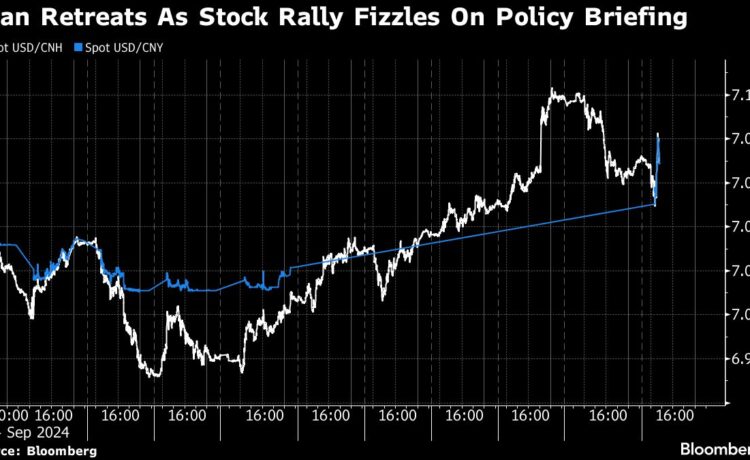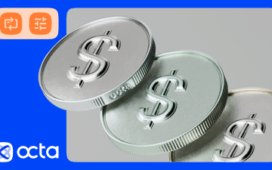(Bloomberg) — China’s onshore yuan had its worst day in more than a year after a week-long break, fueling a broader weakening among Asian currencies as traders rolled back bets on the world’s second-largest economy.
Most Read from Bloomberg
The onshore yuan dropped as much as 0.9% against the greenback on Tuesday, its worst performance since June 2023, knocking sentiment for currencies including the Australian dollar and the South Korean won. The decline in the onshore yuan was in part a catch-up trade after the Golden Week holiday in mainland China; the offshore yuan lost more than 1% of its value during the break.
The widespread currency declines show how shifting bets on the world’s two largest economies are weighing on the global foreign-exchange market. Traders pared their expectations of US interest-rate cuts last week, following a strong jobs report. Now, a disappointing briefing by China’s top economic planning body has undermined hopes of big fiscal stimulus — and had a knock-on impact on a range of asset prices.
“Hopes were raised but the delivery was disappointing,” said Christopher Wong, a currency strategist at Oversea-Chinese Banking Corp. “The lack of follow-through is a setback to sentiments, and yuan-sensitive currencies, including the Australian dollar, the South Korean won and the Malaysian ringgit.“
The currency selloff reversed a brief period of optimism. A gauge of Asian currencies surged nearly 5% from this year’s low to its highest level since mid-2023 in September, after Beijing announced a raft of stimulus measures including interest-rate cuts and support for the property market.
But on Tuesday, when mainland China returned from a one-week break, investors were hit with disappointment. In a highly anticipated press briefing, China’s National Development and Reform Commission said the country’s economic targets this year can be met but stopped short of introducing new stimulus measures. That underwhelmed investors who had been hoping the government would unveil fiscal support during the press briefing.
“There was a huge gap between the market expectations and the NDRC delivery this morning,” said Kiyong Seong, lead Asia macro strategist at Societe Generale SA in Hong Kong. “A strong yuan needs higher China rates associated with strong fiscal stimulus, especially given a resurging dollar rate. Therefore, dollar-yuan is unlikely to test 7.0 for the time being too.”
A double-digit rally in China’s onshore stock market fizzled out during the briefing, while stocks in Hong Kong plunged. The Hang Seng Index fell as much as 10% during morning trading, its worst performance since 2008.
China’s benchmark yields pared gains of as much as seven basis points recorded at market open to trade at 2.18% around noon.
“While there were further details on previous measures and the NDRC alluded to more stimulus in the pipeline, there were no fresh measures announced,” said Mitul Kotecha, head of foreign-exchange and emerging markets macro strategy at Barclays Bank Plc. “As such, this has helped to dampen sentiment for yuan and related Asia foreign-exchange while fueling more support for the dollar.”
The offshore yuan erased the morning’s gains and the onshore rate extended declines during the NDRC briefing. The Bloomberg Asia Dollar Index slid as much as 0.5%, the most in a month.
Also on Tuesday, the People’s Bank of China set its reference rate weaker than previous fixings, which also weighed on the yuan.
“The jury is still out on whether the stimulus will work,” said Alex Loo, a foreign-exchange and macro strategist at TD Securities. “The bullish sentiment in China financial markets can quickly reverse, undermining PBoC’s efforts if we don’t hear anything from the State Council or Ministry of Finance on a new fiscal package.“
Speculators could resume short bets targeting the yuan, pushing it toward 7.15, he added.
–With assistance from Iris Ouyang.
(Added detail on offshore yuan performance during Golden Week in the second pargraph)
Most Read from Bloomberg Businessweek
©2024 Bloomberg L.P.





